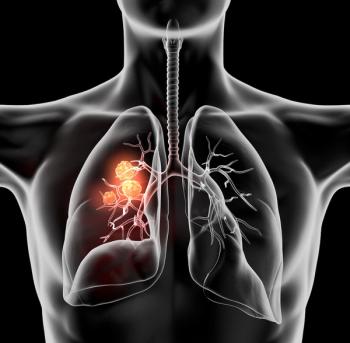
BMS-986279 Shows Feasibility as Non-Invasive fuc-GM1 Assessment in ES-SCLC
Tumor penetration of atigotatug in fuc-GM1-positive lung, liver, and bone lesions was observed in those with extensive-stage small cell lung cancer.
BMS-986279, a zirconium-89–labelled anti-Fucosyl-monosialoganglioside-1 (fuc-GM1) monoclonal antibody, showed feasibility as a non-invasive imaging biomarker of whole-body fuc-GM1 expression in a small cohort of patients with treatment-naïve extensive-stage small cell lung cancer (ES-SCLC), according to results from the first-in-human CA001-050 study (NCT04702880) presented at the
Findings from the study revealed that BMS-986279 uptake was observed in primary tumors and distant metastases. Among 7 patients who were dosed with BMS-986279, 5 showed a strong PET uptake, with 1 patient showing moderate PET uptake, and an additional patient showing no PET uptake. Furthermore, 4 patients experienced partial responses per RECIST v 1.1 criteria, all of whom exhibited strong tracer uptake and tumor penetration.
Furthermore, 2 patients were progression-free as of data cut-off, and 3 patients had survived, all of whom exhibited strong PET uptake. Of note, 1 patient with strong PET uptake experienced a 3-month progression-free survival (PFS) and was alive as of data cutoff. Another with strong PET uptake progressed after 4.7 months and died after 9.4 months.
The patient with moderate PET uptake experienced a 1.3-month PFS and a 2.9-month overall survival (OS), and the patient who did not experience any PET uptake had a PFS and OS of 1.0 month. In the patient with moderate uptake, large cell neuroendocrine carcinoma was identified, which initially showed stable disease and then early progression not corresponding with fuc-GM1 expression measured by immunohistochemistry (IHC) straining and liquid chromatography-mass spectrometry (LC-MS). In the patient with absent PET uptake, a small brain lesion showed no clear uptake.
“The [BMS-986279] tracer is suitable for human dosing and proves capable of non-invasive assessment of whole-body fuc-GM1 in the [ES-SCLC] population,” Diederik Grootendorst, MSc, PhD, global scientific director of Clinical Oncology Imaging at Bristol Myers Squibb, stated in the presentation.1 “PET positivity corresponded with fuc-GM1 expression per IHC and LC-MS, although the sample size was limited. Results suggest that tumor penetration of the atigotatug monoclonal [antibody] labeled with zirconium-89 in positive lesions is strong in lung, liver, and bone lesions.”
A total of 15 of 120 patients with treatment-naïve ES-SCLC with an ECOG performance status of 0 to 1 in the CA001-050 study were assigned to receive chemotherapy, nivolumab (Opdivo), atigotatug, and BMS-986279 in a PET substudy. The remaining 105 were randomly assigned 1:1 to receive either chemotherapy, nivolumab, and atigotatug or chemotherapy and nivolumab. Those enrolled were stratified by liver metastases and performance status.
Patients in the substudy received carboplatin, etoposide, and nivolumab with or without atigotatug and BMS-986279 as induction therapy for four 21-day cycles and received treatment every 3 weeks. Subsequent maintenance therapy with nivolumab with or without atigotatug occurred in 28-day cycles until disease progression, unacceptable toxicity, or 2 years of follow-up.
The first 5 patients of the substudy were given 37 MBq of intravenous BMS-986279 and underwent whole body PET on days 1, 4 ± 1, 6 ± 1, and 8 ± 1 to determine its safety, biodistribution, and dosimetry. Thereafter, patients received 37 MBq of BMS-986279 and underwent whole body PET on day 8 ± 1. The investigational tracer was found suitable for human dosing with no tracer-related adverse effects.
The primary end point of the trial was PFS by blinded independent committee review per RECIST v 1.1 criteria. Secondary end points included objective response rate, duration of response, OS, and immunogenicity.2 The exploratory end point of the PET substudy was associations of BMS-986279 PET tracer uptake of biopsied lesions with fuc-GM1 expression levels by IHC, LC-MS, and clinical outcomes.
References
- Grootendorst DJ, Hiltermann JN, Bahce I, et al. First in human medical imaging of zirconium-89 labelled anti-fuc-GM1 monoclonal antibody (BMS-986279) in patients with extensive-stage small cell lung cancer. Presented at 2025 Society of Nuclear Medicine & Molecular Imaging Annual Meeting; June 21-24, 2025; New Orleans, LA. SS19
- A study of BMS-986012 in combination with carboplatin, etoposide, and nivolumab as first-line therapy in extensive-stage small cell lung cancer. ClinicalTrials.gov. Updated July 17, 2024. Accessed June 25, 2025. https://tinyurl.com/t366z5ah
Newsletter
Stay up to date on recent advances in the multidisciplinary approach to cancer.



















































































